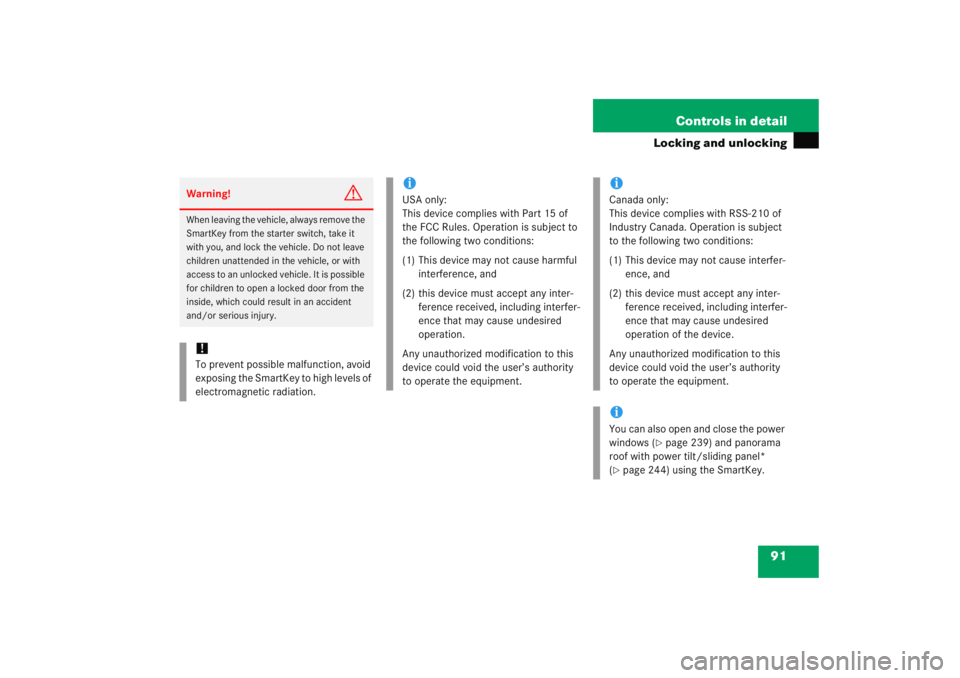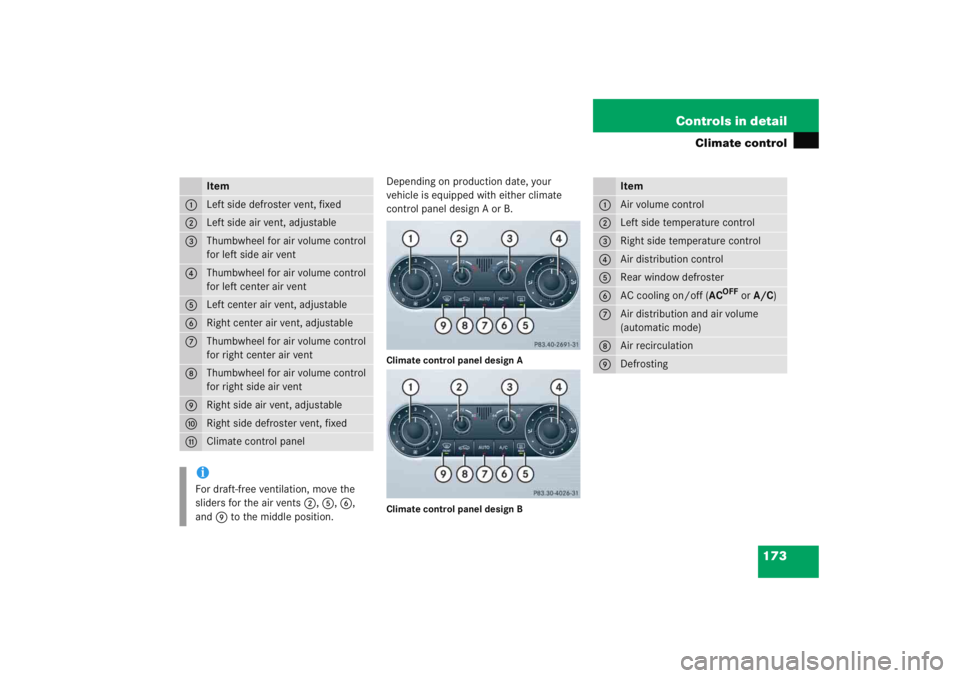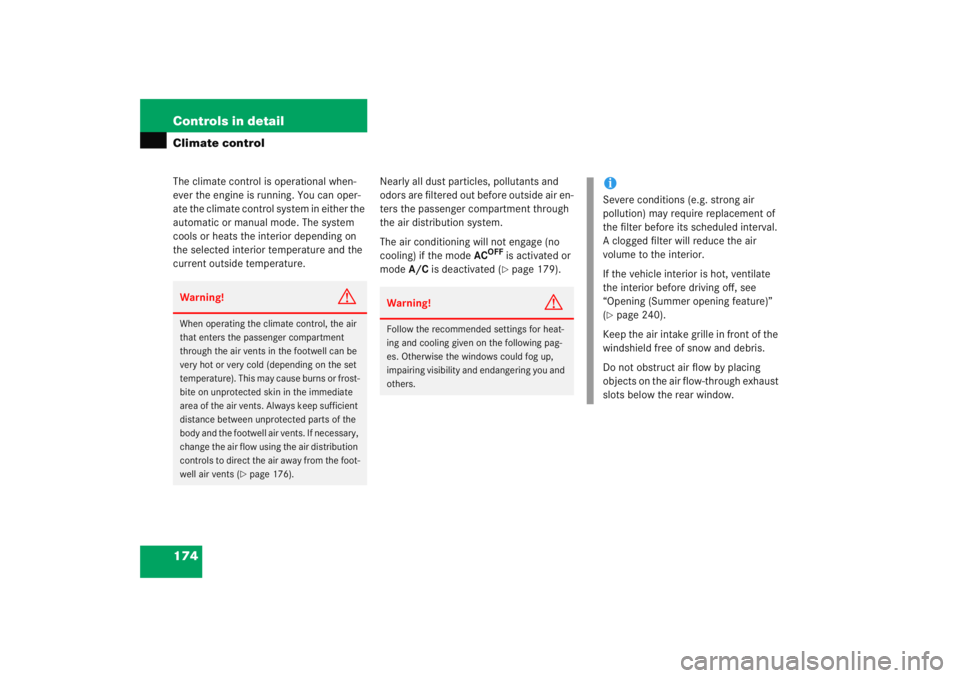Page 90 of 474
89
Controls in detail
Locking and unlocking
Seats
Memory function*
Lighting
Instrument cluster Control system
Manual transmission
Automatic transmission*
Good visibility
Climate control
Automatic climate control* Audio system
Power windows
Panorama roof with power tilt/sliding panel*
Driving systemsLoading
Useful features
Page 92 of 474

91
Controls in detail
Locking and unlocking
Warning!
G
When leaving the vehicle, always remove the
SmartKey from the starter switch, take it
with you, and lock the vehicle. Do not leave
children unattended in the vehicle, or with
access to an unlocked vehicle. It is possible
for children to open a locked door from the
inside, which could result in an accident
and/or serious injury.!To prevent possible malfunction, avoid
exposing the SmartKey to high levels of
electromagnetic radiation.
iUSA only:
This device complies with Part 15 of
the FCC Rules. Operation is subject to
the following two conditions:
(1) This device may not cause harmful
interference, and
(2) this device must accept any inter- ference received, including interfer-
ence that may cause undesired
operation.
Any unauthorized modification to this
device could void the user’s authority
to operate the equipment.
iCanada only:
This device complies with RSS-210 of
Industry Canada. Operation is subject
to the following two conditions:
(1) This device may not cause interfer- ence, and
(2) this device must accept any inter- ference received, including interfer-
ence that may cause undesired
operation of the device.
Any unauthorized modification to this
device could void the user’s authority
to operate the equipment.iYou can also open and close the power
windows (
�page 239) and panorama
roof with power tilt/sliding panel*
(
�page 244) using the SmartKey.
Page 169 of 474

168 Controls in detailGood visibilityAuto-dimming rear view mirrors*
The reflection brightness of the exterior
rear view mirror on the driver’s side and
the interior rear view mirror will respond
automatically to glare when�
the ignition is switched on
and
�
incoming light from headlamps falls on
the sensor in the interior rear view mir-
ror.
The rear view mirror will not react if
�
reverse gear is engaged
�
the interior lighting is turned on.
Warning!
G
The auto-dimming function does not react if
incoming light is not aimed directly at sen-
sors in the interior rear view mirror.
The interior rear view mirror and the exterior
rear view mirror on the driver’s side do not
react, for example, when transporting cargo
which covers the rear window.
Glare can endanger you and others.Warning!
G
In the case of an accident liquid electrolyte
may escape from the mirror housing if the
mirror glass breaks.
Electrolyte has an irritating effect. Do not
allow the liquid to come into contact with
eyes, skin, clothing, or respiratory system.
In case it does, immediately flush affected
area with water, and seek medical help if
necessary.
!Electrolyte drops coming into contact
with the vehicle paint finish can be
completely removed only while in the
liquid state by applying plenty of water.Warning!
G
Exercise care when using the
passenger-side exterior rear view mirror.
The mirror surface is convex (outwardly
curved surface for a wider field of view).
Objects in mirror are closer than they
appear. Check your inside rear view mirror
or glance over your shoulder before chang-
ing lanes.
Page 171 of 474

170 Controls in detailGood visibility�
Swing sun visors down when you expe-
rience glare.
�
To use mirror, lift up mirror cover2.
Rear window defroster
The rear window defroster uses a large
amount of power. To keep the battery
drain to a minimum, switch off the defrost-
er as soon as the rear window is clear.
The defroster is automatically deactivated
after approximately 6 to 17 minutes of
operation depending on the outside tem-
perature.
Activating�
Press button F or 1 in the
climate control panel (
�page 173) or
automatic climate.
The indicator lamp on the button
comes on. Deactivating
�
Press button
F or 1 in the
climate control panel (
�page 173) or
automatic climate again.
The indicator lamp on the button goes
out.
iIf sunlight enters through a side
window, disengage sun visor from
mounting 1 and pivot to the side.
Warning!
G
Any accumulation of snow and ice should be
removed from the rear window before driv-
ing. Visibility could otherwise be impaired,
endangering you and others.
Page 172 of 474
171
Controls in detail
Good visibility
!
If the rear window defroster switches
off too soon and the indicator lamp
starts flashing, this means that too
many electrical consumers are operat-
ing simultaneously and there is insuffi-
cient voltage in the battery. The system
responds automatically by deactivating
the rear window defroster.
As soon as the battery has sufficient
voltage, the rear window defroster
automatically turns itself back on.
Page 174 of 474

173
Controls in detail
Climate control
Depending on production date, your
vehicle is equipped with either climate
control panel design A or B.Climate control panel design A
Climate control panel design B
Item
1
Left side defroster vent, fixed
2
Left side air vent, adjustable
3
Thumbwheel for air volume control
for left side air vent
4
Thumbwheel for air volume control
for left center air vent
5
Left center air
vent, adjustable
6
Right center air vent, adjustable
7
Thumbwheel for air volume control
for right center air vent
8
Thumbwheel for air volume control
for right side air vent
9
Right side air vent, adjustable
a
Right side defroster vent, fixed
b
Climate control paneliFor draft-free ventilation, move the
sliders for the air vents 2,5 ,6 ,
and 9 to the middle position.
Item
1
Air volume control
2
Left side temperature control
3
Right side temperature control
4
Air distribution control
5
Rear window defroster
6
AC cooling on/off ( AC
OFF
or A/C )
7
Air distribution and air volume
(automatic mode)
8
Air recirculation
9
Defrosting
Page 175 of 474

174 Controls in detailClimate controlThe climate control is operational when-
ever the engine is running. You can oper-
ate the climate control system in either the
automatic or manual mode. The system
cools or heats the interior depending on
the selected interior temperature and the
current outside temperature.Nearly all dust particles, pollutants and
odors are filtered out before outside air en-
ters the passenger compartment through
the air distribution system.
The air conditioning will not engage (no
cooling) if the mode
AC
OFF
is activated or
mode A/C is deactivated (�page 179).
Warning!
G
When operating the climate control, the air
that enters the passenger compartment
through the air vents in the footwell can be
very hot or very cold (depending on the set
temperature). This may cause burns or frost-
bite on unprotected skin in the immediate
area of the air vents. Always keep sufficient
distance between unprotected parts of the
body and the footwell air vents. If necessary,
change the air flow using the air distribution
controls to direct the air away from the foot-
well air vents (
�page 176).
Warning!
G
Follow the recommended settings for heat-
ing and cooling given on the following pag-
es. Otherwise the windows could fog up,
impairing visibility and endangering you and
others.
iSevere conditions (e.g. strong air
pollution) may require replacement of
the filter before its scheduled interval.
A clogged filter will reduce the air
volume to the interior.
If the vehicle interior is hot, ventilate
the interior before driving off, see
“Opening (Summer opening feature)”
(�page 240).
Keep the air intake grille in front of the
windshield free of snow and debris.
Do not obstruct air flow by placing
objects on the air flow-through exhaust
slots below the rear window.
Page 176 of 474

175
Controls in detail
Climate control
Deactivating the climate control system
Deactivating�
Set air volume control
1 (
�page 173)
to position 0.
Reactivating
�
Set air volume control 1 (
�page 173)
to any speed.
Setting the temperature
Use temperature controls 2 and 3
(�page 173) to separately adjust the air
temperature on each side of the passenger
compartment. You should raise or lower
the temperature setting in small incre-
ments, preferably starting at 72°F (22°C). Increasing
�
Turn temperature control
2 or 3
slightly to the right.
The climate control system will corre-
spondingly adjust the interior air tem-
perature.
Decreasing
�
Turn temperature control 2 or 3
slightly counterclockwise.
The climate control system will corre-
spondingly adjust the interior air tem-
perature.
iWhen the air conditioning is switched
off, the outside air supply and circula-
tion are also switched off. Only choose
this setting for a short time. Otherwise
the windows could fog up.
iWhen operating the climate control
system in automatic mode, you will
only rarely need to adjust the tempera-
ture, air volume and air distribution.